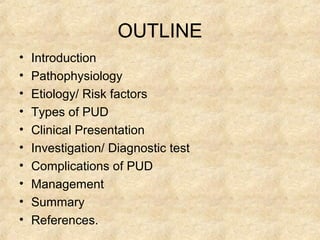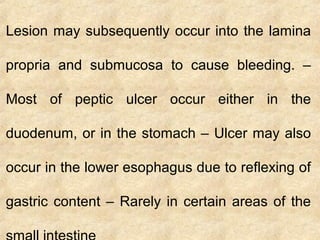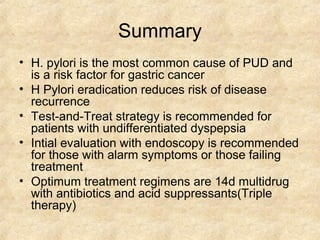Peptic ulcer
- 1. Peptic Ulcer Disease By Aniedu, Ugochukwu
- 2. OUTLINE • Introduction • Pathophysiology • Etiology/ Risk factors • Types of PUD • Clinical Presentation • Investigation/ Diagnostic test • Complications of PUD • Management • Summary • References.
- 3. INTRODUCTION • Peptic Ulcer is a lesion in the lining (mucosa) of the digestive tract, typically in the stomach or duodenum, caused by the digestive action of pepsin and stomach acid.
- 4. Lesion may subsequently occur into the lamina propria and submucosa to cause bleeding. – Most of peptic ulcer occur either in the duodenum, or in the stomach – Ulcer may also occur in the lower esophagus due to reflexing of gastric content – Rarely in certain areas of the
- 6. Under normal conditions, a physiologic balance exists between gastric acid secretion and gastroduodenal mucosal defense. Mucosal injury and, thus, peptic ulcer occur when the balance between the aggressive factors and the defensive mechanisms is disrupted. Aggressive factors, such as NSAIDs, H pylori infection, alcohol, bile salts, acid, and pepsin, can alter the mucosal defense by allowing back diffusion of hydrogen ions and subsequent epithelial cell injury.
- 7. ETIOLOGY/ RISK FACTORS • Lifestyle – Smoking – Acidic drinks – Medications • H. Pylori infection – 90% have this bacterium – Passed from person to person (fecal-oral route or oral-oral route) • Age – Duodenal 30-40 – Gastric over 50 • Gender – Duodenal: are increasing in older women • Genetic factors – More likely if family member has Hx • Other factors: stress can worsen but not the cause
- 8. TYPES • GASTRIC PEPTIC ULCER • DUODENAL PEPTIC ULCER
- 9. Gastric and Duodenal Ulcers
- 14. INVESTIGATION • Stool examination for fecal occult blood. • Complete blood count (CBC) for decrease in blood cells.
- 15. DIAGNOSTIC TEST • Esophagogastrodeuodenoscopy (EGD) – Endoscopic procedure • Visualizes ulcer crater • Ability to take tissue biopsy to R/O cancer and diagnose H. pylori – Upper gastrointestinal series (UGI) • Barium swallow • X-ray that visualizes structures of the upper GI tract – Urea Breath Testing • Used to detect H.pylori • Client drinks a carbon-enriched urea solution • Exhaled carbon dioxide is then measured
- 16. In all patients with “Alarming symptoms” endoscopy is required. Dysphagia. Weight loss. Vomiting. Anorexia. Hematemesis or Melena
- 17. Complications of Peptic Ulcers • Hemorrhage – Blood vessels damaged as ulcer erodes into the muscles of stomach or duodenal wall – Coffee ground vomitus or occult blood in tarry stools • Perforation – An ulcer can erode through the entire wall – Bacteria and partially digested food spill into peritoneum=peritonitis • Narrowing and obstruction (pyloric) – Swelling and scarring can cause obstruction of food leaving stomach=repeated vomiting
- 18. MANAGEMENT • LIFE STYLE MODIFICATION • HYPOSECRETORY DRUG THERAPY • H. pylori ERADICATION THERAPY • SURGERY
- 20. Hyposecretory Drugs • Proton Pump Inhibitors – Suppress acid production – Prilosec, Prevacid • H2-Receptor Antagonists – Block histamine-stimulated gastric secretions – Zantac, Pepcid, Axid • Antacids – Neutralizes acid and prevents formation of pepsin (Maalox, Mylanta) – Give 2 hours after meals and at bedtime • Prostaglandin Analogs – Reduce gastric acid and enhances mucosal resistance to injury – Cytotec • Mucosal barrier fortifiers – Forms a protective coat • Carafate/Sucralfate – cytoprotective
- 21. H. pylori Eradication Therapy:
- 22. Indications: Failure of medical treatment. Development of complications High level of gastric secretion and combined duodenal and gastric ulcer. Principle: Reduce acid and pepsin secretion.
- 23. Types of Surgical Procedures • GASTROENTEROSTOMY Creates a passage between the body of stomach to small intestines. Allows regurgitation of alkaline duodenal contents into the stomach. Keeps acid away from ulcerated area
- 24. Types of Surgical Procedures • VAGOTOMY – Cuts vagus nerve – Eliminates acid- secretion stimulus
- 25. Types of Surgical Procedures • PYLOROPLASTY – Widens the pylorus to guarantee stomach emptying even without vagus nerve stimulation
- 26. Types of Surgical Procedures • ANTRECTOMY/ SUBTOTAL GASTRECTOMY – Lower half of stomach (antrum) makes most of the acid – Removing this portion (antrectomy) decreases acid production • SUBTOTAL GASTRECTOMY – Removes ½ to 2/3 of stomach • Remainder must be reattached to the rest of the bowel – Billroth I – Billroth II
- 27. Billroth I • Distal portion of the stomach is removed • The remainder is anastomosed to the duodenum
- 28. Billroth II • The lower portion of the stomach is removed and the remainder is anastomosed to the jejunum
- 29. Postoperative Care – NG tube – care and management – Monitor for post-operative complications
- 30. Post-op Complications • Bleeding – Occurs at the anastomosed site – First 24 hours and post-op days 4-7 • Duodenal stump leak – Billroth II – Severe abdominal pain – Bile stained drainage on dressing • Gastric retention – WILL NEED TO PUT NG TUBE BACK IN • Dumping Syndrome. – Prevalent with sub total gastrostomies – Early-30 minutes after meals – Vertigo, tachycardia, syncope, sweating, pallor, palpitations – Late – 90 min-3 hours after meals • Rx: Decrease CHO intake, Eat slowly, Avoid fluids during meals, Increase fat, Eat small, frequent meals • Anemia – Rapid gastric empyting decreases absorption of iron • Malabsorption of fat – Decreased acid secretions, decreased pancreatic secretions, increased upper GI mobility
- 31. Summary • H. pylori is the most common cause of PUD and is a risk factor for gastric cancer • H Pylori eradication reduces risk of disease recurrence • Test-and-Treat strategy is recommended for patients with undifferentiated dyspepsia • Intial evaluation with endoscopy is recommended for those with alarm symptoms or those failing treatment • Optimum treatment regimens are 14d multidrug with antibiotics and acid suppressants(Triple therapy)
- 32. REFERENCES • http://emedicine.medscape.com/article/181753-overview#showall. Retrieved 28th Jan, 2016 • Fendrick M, Forsch R etal. Peptic Ulcer Disease Guidleines for Clinical Care. University of Michigan Health System May 2005 • American Gastroenterological Association medical position statement: evaluation of dyspepsia. Gastroenterology 1998;114:579-81. • Krogfelt K, Lehours P, Mégraud F. Diagnosis of Helicobacter pylori Infection. Helicobacter 2005 10:s1 5 • Meurer L, Bower D. Management of Helicobacter pylori Infection. American Family Physician Vol 65, No. 7, 2002 pp 1327-1336 • Standards of Practice Committee of the American Society for Gastrointestinal Endoscopy; The role of endoscopy in dyspepsia. Gastrointestinal Endoscopy Vol 54, No. 6, 2001 pp 815-817 • Vaira D, Gatta L, Ricci C, et al. Peptic ulcer and Helicobacter pylori: update on testing and treatment. Postgrad Med 2005;117(6):17-22, 46
Editor's Notes
- #16: A barium examination of the GI tract can be used to establish a duodenal ulcer. If perforation is suspected the health care provider usually requests an upright abdomen series to demonstrate free air in the peritoneum. Do not use barium where free air is a possibility.
- #18: Hemorrhage: With massive bleeding the patient vomits bright red or coffee ground blood. Minimal bleeding from ulcers is manifested by occult blood in a tarry stool (melena). Perforation: Gastric and duodenal ulcers can perforate or bleed. Perforation occurs when the ulcer becomes so deep that the entire thickness of the stomach or duodenum is worn away. The gastroduodenal contents may then empty into the peritoneal cavity. Symptoms of perforation are sudden, sharp pain, the abdomen is tender, rigid, and boardlike. The patient assumes the fetal position, knees to chest. Client can become acutely ill within hours. Peforation is considered a surgical emergency and can be life threatening. If this occurs the physician needs to be notified immediatley.
- #21: Hyposecretory drugs produce a reduction in gastric acid secretions. Your proton pump inhibitors have emerged as the drug class of choice for treating clients with acid-related disorders. These drugs suppress acid production. They include Prilosec and Previcid. Your H2 receptor antagonists block histamine stimulated gastric secretions. Antacids neutralizes acid and prevents formation of pepsin. The prostoglandin analogs reduce gastric acid and enhance mucosal resistance to injury. The drug Carafate acts as a mucosal barrier by forming a protective coating
- #24: A simple gastroenterostomy permits neutralization of gastric acid by regurgitation of alkaline duodenal contents into the stomach. The surgeon creates a passage between the body of the stomach and the small bowel. Drainage of the gastric contents diverts acid from the ulcerated area and facilitates healing.
- #25: A vagotomy eliminates the acid-secreting stimulus to gastric cells and decreases the responsiveness of parietal cells.
- #26: In this procedure the surgeon enlarges the pyloric stricture by incising the pylorus longitudinally and sutures the incision transversely.
- #30: The postoperative plan of care is similar for all of the gastric operative procedures. These patients will have NG tubes in place and attached to low wall suction. Ensure the patency of these tubes. Irrigation or repositioning of the NG tube is not done after gastric surgery unless specifically ordered by the doctor.
- #31: Dumping Syndrome: is a term that refers to a constellation of vasomotor symptoms after eating, especially following a Billiroth II procedure. This syndrome is believed to be caused because of the rapid emptying of the stomach contents into the small intestine, which shifts fluid into the gut, causing abdominal distention. Early manifestations occur within 30 minutes of eating. Symptoms include vertigo, tachycardia, syncope, pallor, sweating and palpatations. Late dumping syndrome occurs 90 minutes to 3 hours after eating, and is caused by a release of an excessive amount of insulin. The insulin release follows a rapid rise in the blood glucose level that results from the rapid entry of high carbohydrate food into the jejunum. Symptoms include dizziness, light-headedness, palpatations, diaphoresis, and confusion. Dumping syndrome is managed by dietary measures that include decreasing the amount of food taken at one time and eliminating liquids with meals.
































